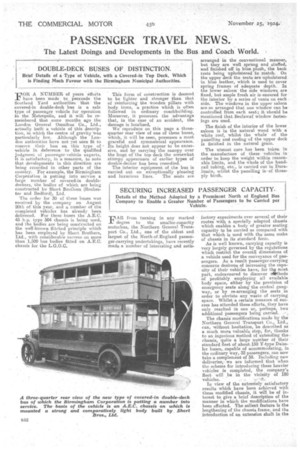PASSENGER TRAVEL NEWS.
Page 26

If you've noticed an error in this article please click here to report it so we can fix it.
The Latest Doings and Developments in the Bus and Coach World.
DOUBLE-DECK BUSES OF DISTINCTION.
Brief Details of a Type of Vehicle, with a Covered-in Top Deck, Which Is Finding Much Favour with the Birmingham Municipal Authorities.
FOR A NUMBER of years efforts have been made to persuade the Scotland Yard authorities that the covered-in double-deck 'bus is a safe type of passenger vehicle for operation in the Metropolis, and it will be remembered that some months ago the London General Omnibus Co., Ltd., aetually built a vehicle of this description, in which the centre of gravity was particularly low. Although the London authorities have not yet seen fit to remove their ban on this type of vehicle in deference to the qualified judgment of passenger-vehicle experts, it is satisfactory, in a measure, to note that developments in this direction are being recorded in other parts of the country. For example, the Birmingham Corporation is putting into service a large number of covered-in doubledeckers, the bodies of which are being constructed by Short Brothers (Rochester and Bedford), Ltd.
The order for 30 of these buses was received by the company on August 20th of.this year, and a number of the completed vehicles has already been delivered. For these buses the A.E.C. 45 h.p. type 504 chassis is being used, and the bodies are being constructed on the well-known ilitched principle which has been employed by Short Brothers, Ltd., with considerable success on more than 1,500 bus bodies fitted on A.E.C. chassis for the L.G.O.C.
This form of construction is deemed to be lighter and stronger than that of reinforcing the Wooden pillars with body irons, a practice which is often followed in ordinary coachbuilding. Moreover, it possesses the advantap that, in the case of an accident, taa • damage is localized, We reproduce on this page a three. quarter rear view of one of these buses, which, it will be seen, possesses a most graceful and symmetrical appearance. Its height does not appear to be excessive, and by carrying the canopy over the front of the top deck the somewhat stumpy appearance of earlier types of double-decker has been remedied.
The interior equipment of the bus is carried out on exceptionally pleasing and luxurious lines. The seats are
arranged in the conventional manner, but they are well sprung and stuffed, and finished off in blue plush, the back rests being upholstered to match. On the upper deck the seats are upholstered in blue leather, which is used to cover spring frames of adequate depth. In the lower saloon the side windows are fixed, but ample fresh air is-ensured for the interior by a series of vents on each side. The windows in the upper saloon are so arranged that one window can be controlled from each seat; it should be mentioned that Beclawuf window fastenings are used.
The finish of the interior of the lower saloon is in the natural wood with a white roof, whilst the whole of the panelling and roofing of the upper deck is finished in the natural grain.
The utmost care has been taken in the manufacture of these vehicles in order to keep the weight within reasonable limits, and the whole of the handrail tubing, etc., is carried out in Duralumin, whilst the panelling is of threeply birch.


































